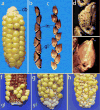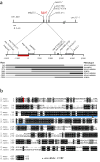The origin of the naked grains of maize
- PMID: 16079849
- PMCID: PMC1464477
- DOI: 10.1038/nature03863
The origin of the naked grains of maize
Abstract
The most critical step in maize (Zea mays ssp. mays) domestication was the liberation of the kernel from the hardened, protective casing that envelops the kernel in the maize progenitor, teosinte. This evolutionary step exposed the kernel on the surface of the ear, such that it could readily be used by humans as a food source. Here we show that this key event in maize domestication is controlled by a single gene (teosinte glume architecture or tga1), belonging to the SBP-domain family of transcriptional regulators. The factor controlling the phenotypic difference between maize and teosinte maps to a 1-kilobase region, within which maize and teosinte show only seven fixed differences in their DNA sequences. One of these differences encodes a non-conservative amino acid substitution and may affect protein function, and the other six differences potentially affect gene regulation. Molecular evolution analyses show that this region was the target of selection during maize domestication. Our results demonstrate that modest genetic changes in single genes can induce dramatic changes in phenotype during domestication and evolution.
Figures





References
-
- Dorweiler J, Stec A, Kermicle J, Doebley J. Teosinte glume architecture1: A genetic locus controlling a key step in maize evolution. Science. 1993;262:233–235. - PubMed
-
- Klein J, Saedler H, Huijser P. A new family of DNA binding proteins includes putative transcriptional regulators of the Antirrhinum majus floral meristem identity gene SQUAMOSA. Mol Gen Genet. 1996;250:7–16. - PubMed
-
- Doebley J. The genetics of maize evolution. Annu Rev Genet. 2004;38:37–59. - PubMed
-
- Maynard Smith J. Macroevolution. Nature. 1981;289:13–14. - PubMed
Publication types
MeSH terms
Substances
Associated data
- Actions
- Actions
- Actions
- Actions
- Actions
- Actions
- Actions
- Actions
- Actions
- Actions
- Actions
- Actions
- Actions
- Actions
- Actions
- Actions
- Actions
- Actions
- Actions
- Actions
- Actions
- Actions
- Actions
- Actions
- Actions
- Actions
- Actions
- Actions
- Actions
- Actions
- Actions
- Actions
- Actions
- Actions
- Actions
- Actions
- Actions
- Actions
- Actions
- Actions
- Actions
- Actions
- Actions
- Actions
- Actions
- Actions
- Actions
- Actions
- Actions
- Actions
- Actions
- Actions
- Actions
- Actions
- Actions
- Actions
- Actions
- Actions
- Actions
- Actions
- Actions
- Actions
- Actions
- Actions
- Actions
- Actions
- Actions
- Actions
- Actions
- Actions
- Actions
- Actions
- Actions
- Actions
- Actions
- Actions
- Actions
- Actions
- Actions
- Actions
- Actions
- Actions
- Actions
- Actions
- Actions
- Actions
- Actions
- Actions
- Actions
- Actions
- Actions
- Actions
- Actions
- Actions
- Actions
- Actions
- Actions
- Actions
- Actions
- Actions
- Actions
- Actions
- Actions
- Actions
- Actions
- Actions
- Actions
- Actions
- Actions
- Actions
- Actions
- Actions
- Actions
- Actions
- Actions
- Actions
- Actions
- Actions
- Actions
- Actions
- Actions
- Actions
- Actions
- Actions
- Actions
- Actions
- Actions
- Actions
- Actions
- Actions
- Actions
- Actions
- Actions
Grants and funding
LinkOut - more resources
Full Text Sources
Other Literature Sources

